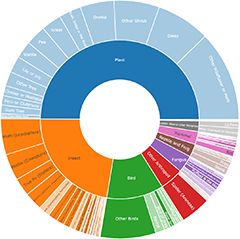Eucalypt Health Surveillance - Greater Melbourne sightings
Posted by Steve818
- Purpose
For use as a reference collection to monitor Eucalypt health in the Greater Melbourne area of Victoria. Eucalypts include the following genera: Eucalyptus, Corymbia and Angophora.
Eucalypt health can be affected by climate change, drought, plant pathogens and pests, environmental weeds, and very high severity fires. For example: Bell Miner - psyllid dieback, Phytophthora dieback, drought-induced fissure - longicorn beetle dieback, drought-induced xylem embolism and cavitation (hydraulic conductance failure), ginger tree syndrome, lack of resprouting of epicormic strands due to vascular cambium death from very high severity fires, novel increase in fire intensity from African lovegrass invasion, and rural dieback caused by nutrient imbalance.
The condition of the Eucalypt canopy, leaves, buds, and bark (particularly on smooth barks) are good indicators of plant health which can be revealed by the sighting photos. NatureMapr has a timeline function which collates sightings overtime of a species at a location. This can show changes in plant health.
Eucalypts are keystone species
Eucalypts are keystone species for many Australian ecosystems. Planted Eucalypts are also strongly associated with insect and bird diversity and this can assist bird populations in adjacent woodland or forest. Sightings of Eucalypts in cultivation are valuable data for understanding if a non-local species is able to flower outside its natural distribtuion. This helps with understanding the impact of climate change. Hence why this project includes planted Eucalypts as well as those that are naturally occurring.
Eucalypt canopies and fine roots affect soil properties, via rainfall through fall, rainfall stem flow, leaf and bark litter, extensive fine root turnover, and mycorrhizae. This has a significant effect on nutrient cycling and understorey vegetation patterns.
How to add your Eucalypt sightings
Add your Eucalypt sightings to the project collection by selecting the star icon at the top right of the sighting page (to the left of the edit option) on your desktop computer, and scroll thru the collection list to find the collection title 'Eucalypt health surveillance - Greater Melbourne'. Don't forget to fill out all the data fields for the Eucalypt sighting: number of the species (i.e. number in the immediate area, usually within 20m, or if uncertain set the number to 1), tree health, height, number of hollows, circumference, canopy radius (if asked), planted or naturally occurring, and use the public comments field for extra plant health information (e.g. disturbances, pests, site history), and for noting different age classes or plant health status of the number recorded.
Helpful id guides: The EUCLID app, and Native Eucalypts of Victoria and Tasmania - South-eastern Australia by Dean Nicolle.
Add a sighting
- Collection type Research project
Follow this collection
Receive alerts of new sightings
SubscribeFilter
- All sightings 9
- Significant sightings 0
- Unidentified sightings 0
Categories
- Plants
- Birds
- Mammals
- Reptiles and Frogs
- Insects
- Spiders (Araneae)
- Other Arthropods
- Other Invertebrates
- Fungi
- Lichens; Mosses & other Bryophytes
- Algae, Cyanobacteria, other bacteria and viruses
- Slime Moulds (Myxomycetes)
- Fossils & Geological Features
- Fish
- Marine Invertebrates
- Marine Algae & Seaweeds
Share to contribute
Share link to contribute to Eucalypt Health Surveillance - Greater Melbourne






















